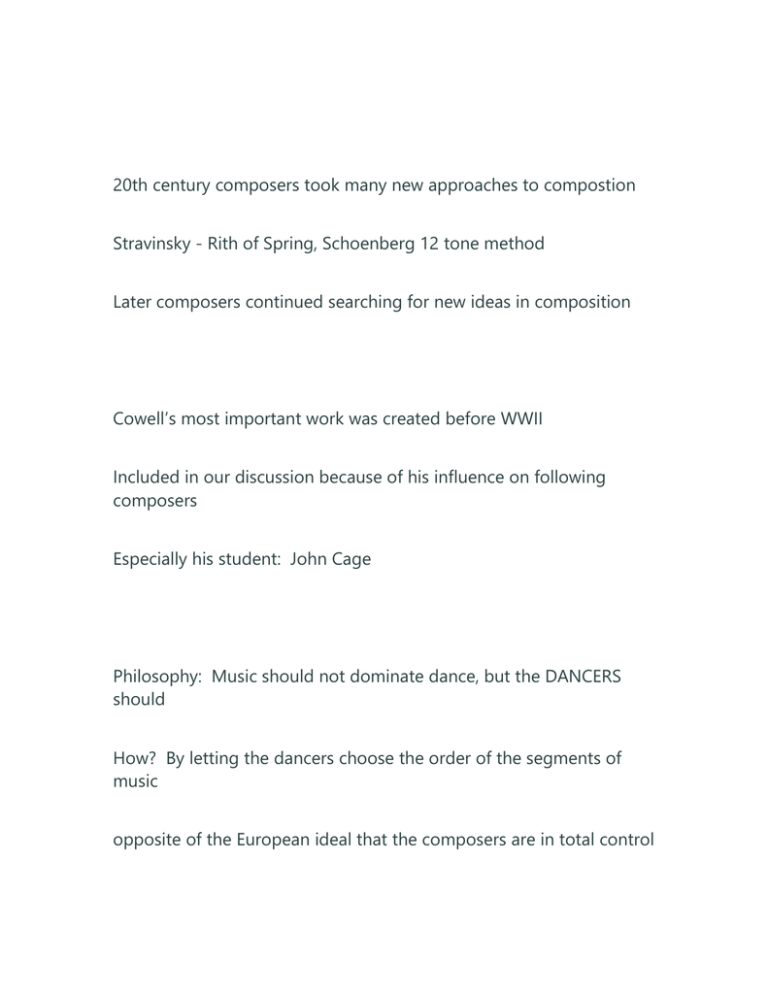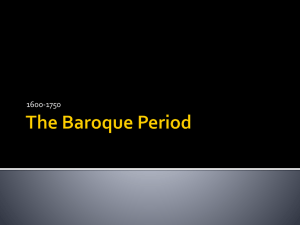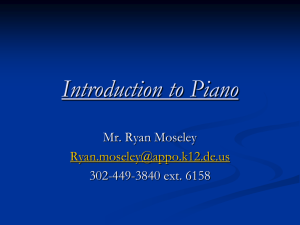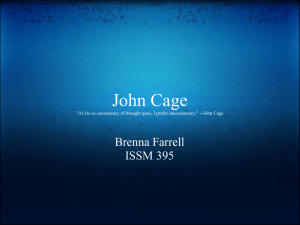Post WWII Innovations 20th century composers took many new
advertisement

Post WWII Innovations 20th century composers took many new approaches to compostion Stravinsky - Rith of Spring, Schoenberg 12 tone method Later composers continued searching for new ideas in composition Henry Cowell (1867-1965) Cowell’s most important work was created before WWII Included in our discussion because of his influence on following composers Especially his student: John Cage Dance Music Philosophy: Music should not dominate dance, but the DANCERS should How? By letting the dancers choose the order of the segments of music opposite of the European ideal that the composers are in total control Leads to a new freedom of performing where CHOICE is given By the 1960s/70s, this new freedom created new performances Performers had a score (music) and could play their part at any time they pleased - and even creating (improv) for certain periods of time this randomness created what is called: aleatory, indeterminacy, or chance music Cowell: Musical Characteristics Smaching down a group of notes on the piano “tone cluster” used in the work: “Tiger” (1928) Tiger Instrument Experimentation New Piano Works - playing the strings Music for performer and assistant performer strums and scrapes the piano strings while an assistant depresses one of the piano’s pedals The piece: “The Banshee” 1925 imitates the Banshee’s screams John Cage (1912-1992) Greatly influenced by non-western music - especially from China Study began with Arnold Schoenberg The “cost” of lessons Cage and Dance Music hired in 1940 to write for an American Dance Company Small theater and stage with only room for piano Cage wanted to provide the percussiveness that was associated with African Dance music the result? Prepared Piano Sonata V from “Sonatas and Interludes for Prepared Piano” 1948 Sonata V The Music he wrote was so successful that he continued to write for prepared piano for the rest of his life (among other composition styles as well) The Sonata V comes from a set of Sonatas written after Cage studied Zen Buddhism - leading to Asian, Gamalan, and Indian influences His Zen Buddhism study included the “Book of Changes” which is read according to a throw of coins to determine the order of reading This aspect of “chance” fascinated Cage and he decided to use it in his music Cage and the “anechoic” the “anechoic” or isolation chamber at Harvard University completely cuts off the individual from the outside world and keeps them in complete silence On this experience, Cage said the experience provided him not with silence, but ... “the unintended operation of my nervous system and the circulation of my blood.” 4’33” “happenings” - never repeated the same way twice Later works: electronics mixed with live sounds “Atlas Eclipticalis” (1961-62) 86 instrumental parts for any ensemble the note heads dictated by the map of the universe A traveller wandering the earth "Atlas" Electronic Music Electronic Technology in the 1950s and 60s made possible changes in the way music could be composed and performed “muisque conctrete” the use of any sound - such as street traffic noise, or from traditional instruments, which then can be manipulated on recorded tape sped up, slowed down, combinations, human singing and speech, cut and pasted etc... the Synthesizer - creator of electronic sounds, makes it possible to create a huge array of sounds and noises for composition Edgard Varese (1883-1965) defined music as “organized sound” he meat ALL sound Poeme Electronique (1958) Combination of electronically produced sounds and muisque concrete Recorded and played through 425 speakers at the Brussels World’s Fair in 1958 A combination of music, lights, pictures, and writing projected ont he walls of the building No real beginning or ending of the piece - a continuous loop"Poeme"




